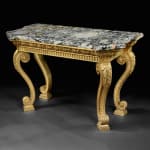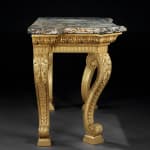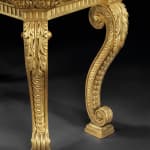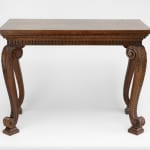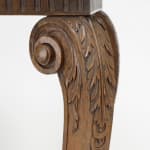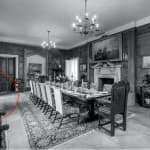Tables

Fig. 1: Console table in the Royal Collection attributed to Goodison, for the Prince of Wales, c. 1732-3, RCIN 1195

Fig. 2: Detail of the royal console table showing the vegetal-carved and fluted frieze and the scrolled leg with acanthus and discs, RCIN 1195

The present table photographed in situ in Dewlish House, Dorset
A GEORGE II GILTWOOD TABLE ATTRIBUTED TO BENJAMIN GOODISON AND WILLIAM KENT
Width: 48" 122cm
Depth: 25” 65cm
Further images
Provenance
Dewlish House, Dorset
Literature
Desmond Shawe-Taylor and Wolf Burchard, The First Georgians: Art and Monarchy 1714-1760 (London: 2014)
Susan Weber, William Kent: Designing Georgian Britain (Yale: 2013), pp. 453-460, figs. 17.8 & 17.21
Geoffrey Beard, The Work of Robert Adam, Bloomsbury, 1978, and The Georgian Craftsmen, Bloomsbury, 1966.
John Hardy, Samuel Norman and Benjamin Goodison: Cabinetmakers to the Crown, Furniture History, Vol. 14 (1978), pp. 30–40
A superb and rare George II Giltwood table attributed to Benjamin Goodison and William Kent
English: circa 1740
The design of the present table is attributable to William Kent, the architect, designer, and painter who revolutionised British decorative arts in the early Georgian period. Kent’s distinctive aesthetic, grounded in Roman Baroque classicism, reshaped the interiors of English palaces and aristocratic homes. The present table incorporates a bold combination of scrolled S-shaped supports, richly carved acanthus foliage, fish-scale ornament, and disc-like terminals—a stylistic vocabulary drawn directly from Kent’s immersion in Italian architecture and design during his formative years in Rome and Florence from 1709 to 1719.¹
This specific configuration of motifs—particularly the fish-scale carving, which became a hallmark of Kent’s designs—can be seen in his celebrated furniture for Chiswick House, Hampton Court Palace, and Devonshire House. The fish-scale detail, although applied to wood, owes more to the decorative language of Italian silverwork than to earlier English furniture, reflecting Kent’s penchant for adapting Continental ornamental sources to grand architectural interiors.²
While Kent is regarded as the author of the design, the actual manufacture of his furniture was carried out by a small group of highly skilled craftsmen, among whom Benjamin Goodison was paramount. Goodison, who trained under James Moore—cabinetmaker to George I—succeeded his master in that role and became the principal cabinetmaker to George II. From the early 1730s, Goodison worked closely with Kent on a number of prestigious royal and aristocratic commissions, interpreting his radical designs into highly finished and technically sophisticated furniture.
A compelling comparison can be made with a console table supplied to Frederick, Prince of Wales, in 1732–33, now in the Royal Collection (RCIN 1195), for which Goodison was paid £3.10s.0d. The present table is virtually identical in overall design and detail. Although it is not recorded in surviving bills, Goodison is known to have supplied furniture across multiple royal residences, including Windsor, Kew, Kensington, and St. James’s Palace. His work for the royal family, first under Moore and then independently, positioned him at the very heart of British court taste in the 1730s.³
The frieze of the table, carved with alternating foliage and fluted panels, the dramatic scrolling legs with deeply cut acanthus leaves, the applied discs, and solid block feet, are all characteristic of both Kent’s architectural sensibility and Goodison’s craftsmanship. Constructed in gilded softwood, the table retains the original breche violetta marble top—a rare and costly stone, complementing the opulent gilt surface and enhancing its presence.
While the more simply constructed console in the Royal Collection was likely intended for use in the private apartments of Frederick or George II, a piece of this grandeur—with its sculptural carving and lavish finish—would have been destined for a State Room, forming part of a broader decorative ensemble designed to express monarchical authority and classical grandeur.



